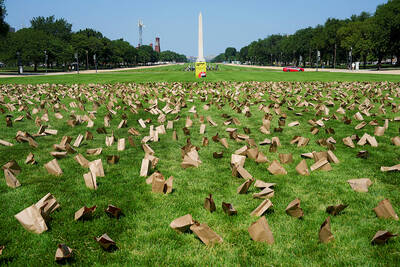Solar module maker Sino-American Silicon Products Inc (SAS, 中美矽晶) yesterday said net profit last year advanced to a historical high, benefiting from price increases and strong investment gains from its silicon wafer manufacturing subsidiaries.
The Hsinchu-based company provided a positive outlook in the expectation of strong demand for solar and renewable energy this year and next, as surging energy prices push countries to diversify energy sources, especially toward renewables.
Demand is also rising as nations set aggressive targets to cut carbon emissions or set “net-zero” timetables, SAS chairwoman Doris Hsu (徐秀蘭) said during a teleconference.

Photo: Chang Hui-wen, Taipei Times
“We see very strong growth starting this year, which will carry over through the next few years,” Hsu said.
Robust demand is also expected to bolster solar prices in the current quarter, extending from last year’s uptrend, Hsu said, adding that prices have been raised to reflect increases in the costs of raw materials, primarily polysilicone, transportation and energy costs.
Higher polysilicone and transportation costs drove down the company’s gross margin in solar products to 16 percent last quarter from 18 percent the previous quarter, the company said, adding that the rate is expected to remain flat this year.
To cope with high demand, SAS expanded solar cell capacity for the first time in about four years, with solar module capacity expansion occurring in Germany, it said.
Net profit last year expanded 0.8 percent to NT$6.82 billion (US$239.67 million), compared with NT$6.33 billion in 2020. Earnings per share rose to NT$11.62, from NT$10.82 the previous year.
Revenue jumped 12.1 percent annually to NT$68.84 billion last year, the best performance since 2018, when revenue hit an all-time high at NT$69.24 billion. About 89 percent of SAS’s revenue last year came from its semiconductor subsidiaries, mainly silicon wafer maker GlobalWafers Co (環球晶圓), 51.17 percent owned by SAS.
Gross margin climbed to an all-time high of 35.6 percent, from 34.4 percent in 2020.
“SAS achieved a positive in gross margin, operating income and cash availability in 2021. Without GlobalWafers, SAS would still be a growing and profitable company,” Hsu said when asked about investors’ concerns about the solar company’s financial performance.
Separately, SAS said that limited effects on its semiconductor operations in Japan were reported after a strong earthquake rocked northern areas of the country on Wednesday night.
“We lost several hours of work time, but operations were fully restored by noon yesterday, except silicon ingot growing,” Hsu said.
GlobalWafers operates five factories in Japan.
It has halted its ingot growing equipment for examination, Hsu said.

Nvidia Corp chief executive officer Jensen Huang (黃仁勳) on Monday introduced the company’s latest supercomputer platform, featuring six new chips made by Taiwan Semiconductor Manufacturing Co (TSMC, 台積電), saying that it is now “in full production.” “If Vera Rubin is going to be in time for this year, it must be in production by now, and so, today I can tell you that Vera Rubin is in full production,” Huang said during his keynote speech at CES in Las Vegas. The rollout of six concurrent chips for Vera Rubin — the company’s next-generation artificial intelligence (AI) computing platform — marks a strategic

Enhanced tax credits that have helped reduce the cost of health insurance for the vast majority of US Affordable Care Act enrollees expired on Jan.1, cementing higher health costs for millions of Americans at the start of the new year. Democrats forced a 43-day US government shutdown over the issue. Moderate Republicans called for a solution to save their political aspirations this year. US President Donald Trump floated a way out, only to back off after conservative backlash. In the end, no one’s efforts were enough to save the subsidies before their expiration date. A US House of Representatives vote

REVENUE PERFORMANCE: Cloud and network products, and electronic components saw strong increases, while smart consumer electronics and computing products fell Hon Hai Precision Industry Co (鴻海精密) yesterday posted 26.51 percent quarterly growth in revenue for last quarter to NT$2.6 trillion (US$82.44 billion), the strongest on record for the period and above expectations, but the company forecast a slight revenue dip this quarter due to seasonal factors. On an annual basis, revenue last quarter grew 22.07 percent, the company said. Analysts on average estimated about NT$2.4 trillion increase. Hon Hai, which assembles servers for Nvidia Corp and iPhones for Apple Inc, is expanding its capacity in the US, adding artificial intelligence (AI) server production in Wisconsin and Texas, where it operates established campuses. This

US President Donald Trump on Friday blocked US photonics firm HieFo Corp’s US$3 million acquisition of assets in New Jersey-based aerospace and defense specialist Emcore Corp, citing national security and China-related concerns. In an order released by the White House, Trump said HieFo was “controlled by a citizen of the People’s Republic of China” and that its 2024 acquisition of Emcore’s businesses led the US president to believe that it might “take action that threatens to impair the national security of the United States.” The order did not name the person or detail Trump’s concerns. “The Transaction is hereby prohibited,”